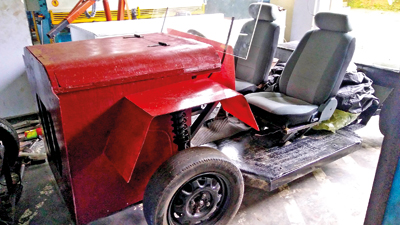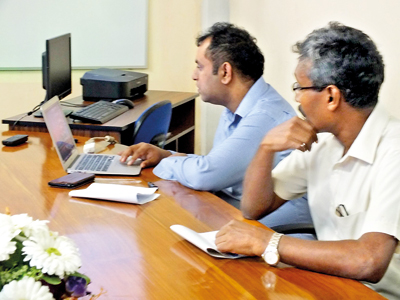New technology developed by Ruhuna University in boat building sector
The world is moving fast in a technologically-advanced world strongly assisted by science and other innovations. Sri Lanka is no exception in employing science and technology for the benefit of the people.

The partly completed body of the motor vehicle using the new technology – VARTM.
However one of the concerns affecting this country is that Sri Lanka has not fully grasped the development of these technologies.
The National Science Foundation (NSF) is one state agency that increasingly fulfils the mission of using essential science and technology for the benefit of Sri Lankans through some of their projects. One such project is the Technology Grant which encourages local talent and transforms these innovations to commercially viable projects.
Local universities too have joined the process of doing research and applying the research findings into projects focussed on commercialising these developments.
The NSF under its Technology Grants Scheme recently awarded Rs.4.8 million to a team of university lecturers headed by Dr.U.I.K. Galappaththi, Senior Lecturer, Department of Mechanical and Manufacturing Engineering, Ruhuna University, for the manufacture of boats using the Vacuum Assisted Resin Transfer Moulding (VARTM) process for the Sri Lankan boat building sector.
This process was successfully used to design composite laminates structures for PANGA 22, Dingy and Flat bottom (Theppama) boats and three prototypes were manufactured.
To understand how this newest method could be applied to the Sri Lankan boat building industry, a team comprising officers of the NSF and Business Times (BT) visited the Ruhuna University Department of Mechanical and Manufacturing Engineering situated in Galle last week.
At the laboratory and the workshop of the department, Dr. Galappaththi with the assistance of a ‘power-point’ presentation said that they got involved in this work to address the existing knowledge gap in the country and through the boat builders who now use the fibre-glass and more common manufacturing technologies such as hand layup and spray-up processes.
He said the new technology is light-weight and durable in the long run. Further, compared to the earlier method, the new method is less environment pollution and would ensure workers don’t inhale harmful fumes.

Dr U.I.K. Galappaththi explaining how the VARTM new technology can be used. Next to him is Dr. Nanditha Hettiarachchi, Head of the Department.
He said that elsewhere in the world the new method is applied and used 50 per cent in the manufacture of aircraft. Not only the aircraft but also in items like railway carriages, structures, motor vehicle manufacture this method is now used.
He showed the team how the new VARTM is used in the manufacture of boats, displaying a partly built motor vehicle body using this technology in the department workshop.
One of the NSF officials,- Janaka Karunasena, Principal Scientific Officer/Head Technology Division, commented that the NSF had studied a report compiled by the Export Development Board (EDB) on boat manufacturing industry in Sri Lanka.
In awarding this grant, he said the NSF has considered the tremendous export potential for boats and noted that the information indicated that the US remained the leader in boat building followed by countries like Italy, the UK, Northern Ireland, the Netherlands, Germany and France.
Dr. Galappaththi said that in Sri Lanka too boat and ship building have shown considerable development within the last few years and is identified as one of the key export sectors. He said that the global industry has shifted from fiberglass to polymer composite structures and use of advanced composite moulding technologies.
He pointed out that the introduction of the new technology in boat making would definitely be a boost to the country’s fishing industry. Further, the technology could be employed in the yacht manufacture which is another export product and could be used in the tourism industry – one of the large income earners for Sri Lanka.
He said that they are prepared to transfer the technology to local boat builders, especially to the SME sector and indicated that now there are a considerable number of inquiries from local manufactures. He said that in fact some of these manufacturers have already adopted the new method. They would visit the large scale manufacturers to provide the know-how and train the workers on the new method. He said that these boat builders could make prior arrangements and visit their workshop.
Ms. Nadeeja Wickramarachchi, NSF Senior Scientific Officer, said that in the technology transfer at the grassroots level to the SME builders, there is some national significance and the boats are now increasingly used in the tourism industry. She said that a major consideration of NSF is the extent of commercialisation and in regard to boat building, it is already commercialised.
Dr. Galappaththi said that he is assisted by Dr. Sumith Baduge, Lecturer of the same Department; T. Ranjan, Lecturer; Dr. W.K. Wimal Siri, Senior Lecturer, University of Moratuwa. Dr. Nanditha Hettiarachchi, Head, Department of Mechanical and Manufacturing Engineering also supported the project.


